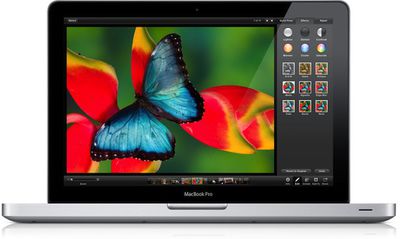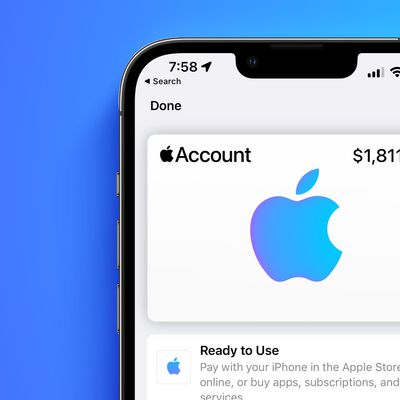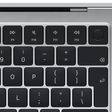Retina-Resolution Displays to Add Up to $100 to Apple's MacBook Pro Costs
With Apple's MacBook Pro line now widely rumored to be gaining ultra high-resolution "Retina" or "HiDPI" displays at next month's Worldwide Developers Conference, CNET reports that such panels are already available in the supply chain and that they carry price premiums of up to $100 over their non-Retina counterparts. But what remains to be seen is whether that price difference will be passed along to consumers or if Apple will find ways to cut costs in other areas in order to maintain its existing price points.
DisplaySearch Senior Analyst Richard Shim says that super high-resolution 13.3-inch and 15.4-inch panels that Apple would be a prime candidate to use are already available from suppliers.
"We're seeing it at 15.4 (inches)," Shim said in an interview yesterday. "You can get it."
According to Shim, a Retina 15.4-inch display at 2880x1800 resolution for a density of 220 pixels per inch (ppi) currently costs approximately $160, a $92 increase over Apple's estimated cost of $68 for the current display in the 15-inch MacBook Pro. In the smaller 13-inch MacBook Pro, a Retina display at 2560x1600 costs $134, a $65 premium over the display used in the current model.

Unaddressed is the 17-inch MacBook Pro, which would require a display of 3840x2400 and undoubtedly carry an even higher price premium over the current display. It is unclear, however, whether the 17-inch MacBook Pro will be receiving the same upgrades as the rest of the family at WWDC, as most rumors so far have pointed to only 13-inch and 15-inch MacBook Pro models being in production. In addition, Apple has been rumored to be following the pattern of its transition to the unibody MacBook Pro design in moving the 17-inch model to the new form factor several months after its smaller siblings.
Shim notes that with these Retina resolution displays available in the supply chain, Apple is the most likely customer for the screens, although he has been unable to confirm what company or companies are purchasing them for use in their computers.
Also unclear is how Apple will handle the cost increase associated with the Retina displays. While some cost savings will be achievable by the removal of the optical drive, Apple will almost certainly see increased costs for storage as the MacBook Pro reportedly moves from traditional hard drives to solid-state drives. While such drives are used in the lower-priced MacBook Air models, higher-end users expected to be drawn to the MacBook Pro will likely demand higher-capacity drives at significantly greater costs. Consequently, it will be interesting to see how Apple ends up pricing the redesigned MacBook Pro given all the changes involved.
Popular Stories
Since the iPhone X in 2017, all of Apple's highest-end iPhone models have featured either stainless steel or titanium frames, but it has now been rumored that this design decision will be coming to an end with the iPhone 17 Pro models later this year.
In a post on Chinese social media platform Weibo today, the account Instant Digital said that the iPhone 17 Pro models will have an aluminum...
Apple is continuing to refine and update iOS 26, and beta three features smaller changes than we saw in beta 2, plus further tweaks to the Liquid Glass design. Apple is gearing up for the next phase of beta testing, and the company has promised that a public beta is set to come out in July.
Transparency
In some apps like Apple Music, Podcasts, and the App Store, Apple has toned down the...
The calendar has turned to July, meaning that 2025 is now more than half over. And while the summer months are often quiet for Apple, the company still has more than a dozen products coming later this year, according to rumors.
Below, we have outlined at least 15 new Apple products that are expected to launch later this year, along with key rumored features for each.
iPhone 17 Series
iPho...
Apple should unveil the iPhone 17 series in September, and there might be one bigger difference between the Pro and Pro Max models this year.
As always, the Pro Max model will be larger than the Pro model:iPhone 17 Pro: 6.3-inch display
iPhone 17 Pro Max: 6.9-inch displayGiven the Pro Max is physically larger than the Pro, it has more internal space, allowing for a larger battery and...
In 2020, Apple added a digital car key feature to its Wallet app, allowing users to lock, unlock, and start a compatible vehicle with an iPhone or Apple Watch. The feature is currently offered by select automakers, including Audi, BMW, Hyundai, Kia, Genesis, Mercedes-Benz, Volvo, and a handful of others, and it is set to expand further.
Apple has a web page with a list of vehicle models that ...
New renders today provide the best look yet relocated Apple logo and redesigned MagSafe magnet array of the iPhone 17 Pro and iPhone 17 Pro Max.
Image via Majin Bu.
Several of the design changes coming to the iPhone 17 Pro model have been rumored for some time, such as the elongated camera bump that spans the full width of the device, with the LiDAR Scanner and flash moving to the right side.
...
Apple's next-generation iPhone 17 Pro and iPhone 17 Pro Max are just over two months away, and there are plenty of rumors about the devices.
Below, we recap key changes rumored for the iPhone 17 Pro models.
Latest Rumors
These rumors surfaced in June and July:Apple logo repositioned: Apple's logo may have a lower position on the back of the iPhone 17 Pro models, compared to previous...
Apple is expanding the ability to add an Apple Account Card to the Wallet app to more countries, according to backend Apple Pay changes.
With iOS 15.5, Apple updated the Wallet app to allow users to add an Apple Account Card, which displays the Apple credit balance associated with an Apple ID.
If you receive an Apple gift card, for example, it is added to an Apple Account that is also...





















